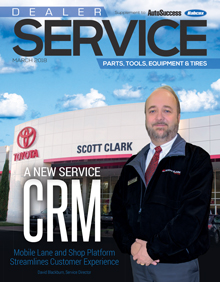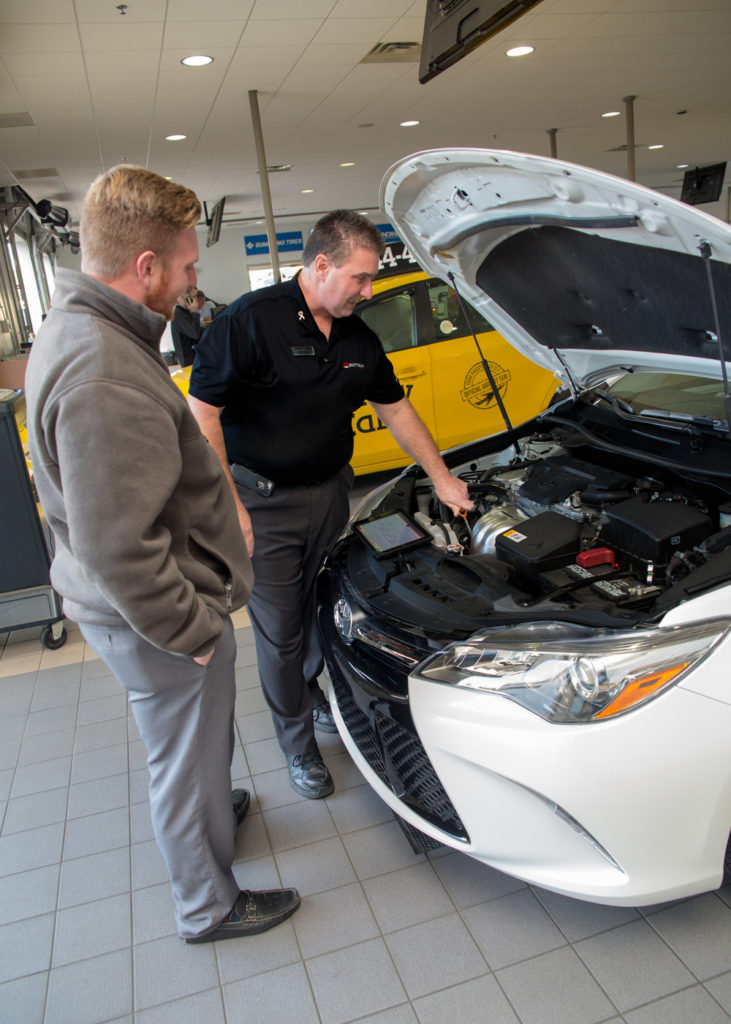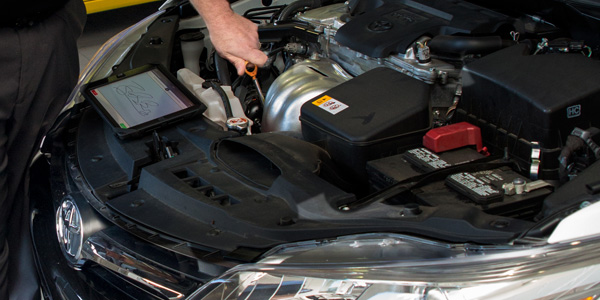 A service department must focus on one fundamental truth to maintain market share and grow business: It must provide an excellent customer experience to keep customers coming back — or its competitors will. Charlotte-based Scott Clark Toyota’s Service Director David Blackburn discusses recent changes they’ve made in the lane to stay ahead of the competition.
A service department must focus on one fundamental truth to maintain market share and grow business: It must provide an excellent customer experience to keep customers coming back — or its competitors will. Charlotte-based Scott Clark Toyota’s Service Director David Blackburn discusses recent changes they’ve made in the lane to stay ahead of the competition.
Dealer Service: Tell us about your dealership — where is it located, what type of market is it and what is your competitive situation?
David Blackburn: Scott Clark Toyota is in a very competitive market in Charlotte, the largest city in North Carolina with just over 2.5 million residents in the metro area. Out of the 177 SE Toyota Dealers, Scott Clark Toyota has been No. 1 in customer-pay RO count for two years running and No. 2 in customer-pay gross service dollars. Needless to say, we maintain a close eye on service retention levels, as customers tend to do business in their own geographic locations. They may drive a long way to buy a car, but they won’t necessarily drive that same distance to service one — unless the service is outstanding, so it’s important to find the right technology partner to help us maintain a competitive advantage in our environment.
DS: When did Scott Clark Toyota implement the ELEAD1ONE Service CRM (Service1One)?
DB: Installation began in June of 2017, and we went live in early July.
DS: Did you shop other systems, and what were the most significant factors in choosing this platform?
DB: We knew implementing new technology and changing processes would be massive undertakings, so we did the research to ensure the correct decision was made the first time. We looked at four other systems, with one of them being our DMS. Two companies were eliminated fairly quickly in the process as they did not meet our criteria. The third system came from one of Toyota’s preferred vendors, and they offered us a pilot program for the SE Toyota region. We were seriously considering that platform, but as we started looking at Service1One, we determined it met our ever-growing list of criteria and offered elements the other systems didn’t have.
Integration and an eye toward the future proved to be critical factors in our decision. This platform combines several departmental functions and integrates them into an all-in-one interface — many of the other systems we looked at cannot get their lane, shop and marketing tools working as one solution. It streamlines work to help explain concepts and offer greater transparency to customers. Another key element to the final decision is our prior experience with ELEAD1ONE. We know them from the sales side of the business, so we knew what to expect from their support model. Support is huge when it comes to this type of software product. Too often in this industry, people come out with these new magic tools and convince us this is the greatest thing. When we get onboard, it fails because of lack of support. Very seldom does an idea fail because of lack of planning or strategy — most fail because of lack of execution. With the company’s support, we were able to make these things a reality.
DS: What were your goals when you decided to implement a tablet lane tool and an electronic MPI tool?
DB: Our goal was to improve customer experience, reduce our cycle times, and communicate repair needs through an enhanced electronic communication network between service advisors, technicians, the parts department and, most importantly, our customers. We also wanted to add accountability to the MPI and ASR processes, as well as present a more clearly defined avenue for tracking and marketing to service customers — especially with declined services. The result we were looking for was increased profits, retention and customer satisfaction scores.
DS: Tell us a little about your operation in terms of how many advisors and technicians you had to train on the toolsets. What was their attitude when faced with a new tool/process, and how did training go?
DB: We have a large service operation, currently employing 70 technicians and 25 service advisors divided into four lateral support groups: a used-car reconditioning group, a TXM Advanced Level 2 Maintenance Team and a TXM (Toyota Express Maintenance) Level 1 Express Maintenance Team. We also have a 20-member Service BDC team trained on Service1One and proficient in their utilization.
 In the beginning, there was a lot of reservation and lack of enthusiasm across the board about the change. We didn’t lose anyone, but there was a lot of, “why change if we’re already the biggest?” mentality. When we communicated to the team that changes were coming, we also shared our goals and reasons, as well as a clear transition timeline. Most importantly, we were able to impress upon our team that these changes were not optional and, regardless of any pushback, they were going to happen. Once that was established, we encouraged and incentivized our folks to be an active part of the transition. We encouraged them to embrace it and be a part of the process. We invited input, took suggestions and attempted to make everyone an active participant.
In the beginning, there was a lot of reservation and lack of enthusiasm across the board about the change. We didn’t lose anyone, but there was a lot of, “why change if we’re already the biggest?” mentality. When we communicated to the team that changes were coming, we also shared our goals and reasons, as well as a clear transition timeline. Most importantly, we were able to impress upon our team that these changes were not optional and, regardless of any pushback, they were going to happen. Once that was established, we encouraged and incentivized our folks to be an active part of the transition. We encouraged them to embrace it and be a part of the process. We invited input, took suggestions and attempted to make everyone an active participant.
The training went more smoothly than I anticipated. The most impressive part was the number and skill level of the trainers. These were men and women who had been in the automotive parts and service world. They were a diverse group able to relate and communicate with our team on every level. We had folks who specialized in training technicians, others working in parts, a team dedicated to the service drive, classroom-style instructors and a group working with management and IT. A relationship formed very quickly and shortly after that came the trust.
DS: What is the overall feeling among your advisors and technicians now that they have gotten used to using the tools on every repair order?
DB: The new platform offers several benefits for both the service team and customers. The online schedule and mobile lane application help the department load shop capacity and simplify the write-up process. Communicating with customers in the way they prefer to hear from us — via text, phone or email — puts them in control of the experience.
Through the use of tablets, the shop process is also streamlined. It allows technicians to perform multi-point inspections quickly and to communicate in real-time with advisors and parts, to easily record declined services and give better explanations of recommended services to customers.
The service platform has now become part of everyday life, and the value to the team is clear. We share our numbers with our team — both good and bad. They see for themselves the improvements that we have accomplished because of this tool. I am very pleased with their progress and most importantly, their willingness to make it better. We actually installed a 65” 4G Ultra TV in the shop so the team can watch our statistics live throughout the day.
DS: Since less than 10 percent of the service managers in the automotive business have a tablet solution working on the same platform as their MPI process, what do you feel has made your store successful in becoming one of a vast minority?
DB: Quite frankly, I don’t understand the pushback. This is the future. Manufacturers are starting to require it. At this point, Toyota doesn’t, but it’s coming. To us, it made sense to get in front of it. By getting in early, we have worked with the company to make system enhancements and improvements (more user-friendly, if you will). With this new platform, we are truly a “Fixed Operations” team. It just made more sense to use a tool that connected all of the team with one provider.
DS: Since 2017 was consumed with adoption and utilization, what are your biggest 2018 Service CRM goals?
DB: Our biggest 2018 goal is continual growth in a tough market. This tool, along with others, allows us to drill down in many areas. It exploits weaknesses, exposes opportunities and, most importantly, allows our management team to identify training opportunities. The new technology offers a wealth of reporting at a click of a button rather than pulling multiple reports from the DMS and piecing together. Now that we’re more familiar with the platform, we’re able to dial into the system a lot deeper and dissect things so that our approach is more strategic in marketing and other efforts. We expect to see continued growth in sales, increased customer retention and improved satisfaction.
DS: How has the support been from the Service1One team since you installed the system?
DB: It’s the most important aspect. Too often in this industry, a new “Magic Tool” appears, and we throw it in place. They train us briefly and then ride off into the sunset. That’s not the case here. They send sustainment teams in regularly (about every six weeks). We have also requested visits, and they always accommodate. We call them on numerous occasions for questions, as well as suggestions. They actually built a custom report for my shop manager with specific data he requested, and he shares that regularly with his teams in huddle meetings.
DS: How do you think the lane and shop tools’ usage has affected service marketing?
DB: As I mentioned earlier, with the reporting now available to us, we can identify opportunities quickly, and with ELEAD1ONE’s other products (Customer Experience Center), we can put together an outgoing phone campaign very quickly; it’s often implemented the same day. We also use their reporting to aid in the development of mail and email marking campaigns. We’ve seen a large jump in declined service approvals, increasing from 14.3 percent (using our previous program) to 19.4 percent with the new technology — and it’s because all the tools work cohesively, so we are always targeting the right audience at the right time, reducing wasted resources and minimizing advertising spend.
We’ve also seen a large increase in immediate approvals of recommended services. Communicating with videos and photos via text or emails is a better way to illustrate problems caught during the inspection process. A visual depiction of the problem always has a better chance of educating and selling the customer in a more transparent manner.
DS: How long do you think it will be until tools like these become the rule and not the exception at dealerships?
DB: That’s hard to say. Automotive manufacturers don’t always move at the pace we would like. That being said, I believe it will be in the very near future as some manufacturers are already insisting on it.
DS: What advice would you give dealership leaders looking to install such a tool in their shops? What steps can they take to ensure smooth transition and adoption?
DB: Be willing to enforce compliance if necessary! That’s a hard statement, but I feel if there is that level of commitment from the top, then the confidence level of the management team will be more committed and thorough with the implementation. Employees will feel the sincerity and be more willing to follow a committed leader, especially if they are included in discussions.
Set your implementation date and stick to it. There will be bumps in the road. We actually took our eyes off CSI and dipped a bit — it’s important to stay vigilant. Trust your trainers with your team — they have a vested interest in your success.
Click here to view more solutions for ELEAD1ONE












